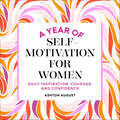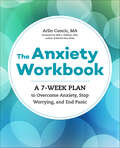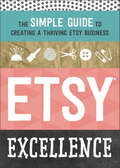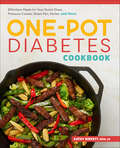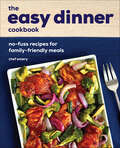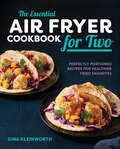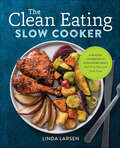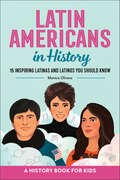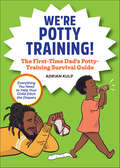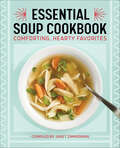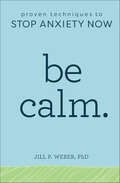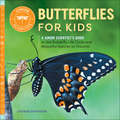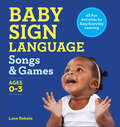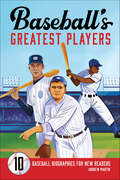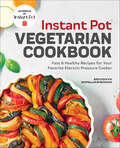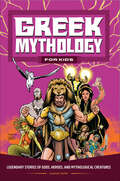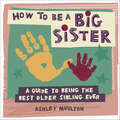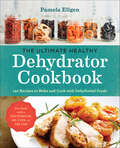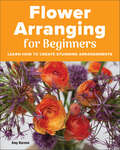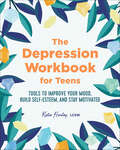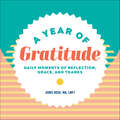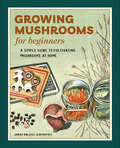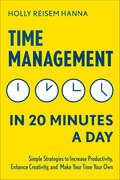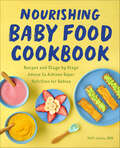- Table View
- List View
A Year of Self Motivation for Women: Daily Inspiration, Courage, and Confidence (A Year of Daily Reflections)
by Ashton AugustFind focus and encouragement with 365 days of motivation Empowering self-talk can boost your confidence and help you stay strong in the face of everyday challenges. This book is full of brief practices and reflections that inspire you to talk to yourself with kindness and develop a more positive mindset so you can truly thrive.This standout among motivational books for women will encourage you to:Try different ways to self-motivate—Navigate your journey toward personal empowerment with an engaging mix of creative activities, positive affirmations, and inspiring quotes.Explore uplifting themes—Instill clarity and confidence into your daily routine with topics like mindfulness, positive thinking, self-compassion, authenticity, and more.Find a flexible format—Get support to carry you through the many seasons of life with entries that follow a calendar year but don't have to be read in any particular order.Get inspired every day of the year with this top choice in self-motivation books for women.
The Anxiety Workbook: A 7-Week Plan to Overcome Anxiety, Stop Worrying, and End Panic
by Arlin CuncicYou're just 7 weeks away from overcoming your anxiety Whether it takes the form of full-blown panic or chronic worry, anxiety can limit the potential of every aspect of your life. Regain control with help from The Anxiety Workbook, a simple, 7-week plan that gives you the tools you need to manage your anxiety so you can feel and function at your best again.You'll learn how to set clear goals, identify and change unhelpful thoughts, and practice new behaviors to diminish the power anxiety has over you. Each week explores a different topic, with cumulative lessons that offer a straightforward path to success. It's time to get free from the obstacles holding you back, break away from negative thought patterns, and alleviate your anxiety over the long term.This anxiety and phobia workbook includes:An easy pace—Take anxiety management at your own pace with exercises that challenge you and address your concerns without stressing you out.A proactive approach—Explore hands-on ways to relieve anxiety with simple, actionable checklists, writing exercises, activities, and more.An evidence-based method—Discover research-supported information and exercises based in cognitive behavioral therapy (CBT).Take the reins of your life back with The Anxiety Workbook.
Etsy Excellence: The Simple Guide to Creating a Thriving Etsy Business
by Tycho PressThe Ambitious Crafter's Guide to a Profitable Etsy ShopMore than a marketplace, Etsy is a community—and being an active, informed member can lead to lucrative results. This book provides actionable steps to help shop owners engage the Etsy community in authentic ways that attract buyers and generate sales.The best Etsy shops stand out among the sea of sellers and a draw loyal customer base, but how they've done it isn't—and shouldn't be—a secret. In these pages, top Etsy sellers share the tools that have helped them, the changes they made that yielded positive results, and their best advice for achieving and sustaining a successful Etsy shop.Beyond sellers' words of wisdom, this book offers a roadmap all Etsy sellers can follow in order to:- Choose keywords and tags to drive traffic to your Etsy shop - Photograph your products for maximum appeal - Create a unique Etsy shop that stands out - Write winning product descriptions - Price your goods appropriately - Market your products effectively on social media platforms - Maintain lasting relationships with your Etsy customers - Diversify your Etsy product offerings
One-Pot Diabetes Cookbook: Effortless Meals for Your Dutch Oven, Pressure Cooker, Sheet Pan, Skillet, and More
by Kathy BirkettMix diabetic-friendly and family-delicious in one easy pot.If you are one of the 30 million Americans struggling with diabetes, the biggest obstacle to meal preparation can be life. Since staring into the refrigerator waiting for inspiration isn't an option, having a simple, delicious, and practical diabetic cookbook like The One-Pot Diabetes Cookbook, is essential to managing your condition.With clear recipes and guidance, this dedicated diabetic cookbook will help you prepare balanced, full meals that will feed your whole family in one pot. Cooking becomes more convenient, mealtime becomes more integrated, and all with just a few kitchen tools and basic cooking techniques—a truly family inclusive diabetic cookbook.This diabetic cookbook features:Many "one-pots"—Preparation options range from a slow cooker to a soup pot, to just a simple salad bowl.Shopping made easy—A diabetic cookbook filled with recipes containing minimal ingredients that are easy to find at the grocery store.Tips and advice—Feed your brain with nutritional and useful knowledge about living with diabetes.Simplify your life and health with a diabetic cookbook written around delicious one-pot meals.Recipes include: Mandarin Orange Chicken Salad, Steak Fajitas, Pot Roast with Vegetables, One-Pot Beef and Veggie Lasagna, Jamaican Jerk Ground Beef Skillet, and Slow-Cooked Seafood Chowder
The Easy Dinner Cookbook: No-Fuss Recipes for Family-Friendly Meals
by Chef EmeryMore than 50 delicious ways to introduce easy, family-friendly dinners into your lifeA busy schedule can leave you feeling like there's no time to make home-cooked meals. The Easy Dinner Cookbook helps you easily fit dinner into your day—even the hectic ones. Based on stress-free cooking methods, these delicious recipes for main dishes will result in tasty dinners everyone will love.With a bevy of simple sides and helpful tips at your disposal, plus intel on optimizing your freezer and leftovers, you'll feel more excited than ever to get in the kitchen and start cooking with this easy cookbook!This easy cookbook for dinner includes:Swift and scrumptious—All 60 recipes in this easy cookbook rely on whole foods and natural ingredients—many require less than 30 minutes to make.Cook with efficiency—Learn how to shop smarter and make the most of your ingredients.Mix it up—Follow the recipe tips in this easy cookbook for inventive variations, pairing options, and ideas for leftovers.Make time for a delicious family dinner with this impressive, easy cookbook.
The Essential Air Fryer Cookbook for Two: Perfectly Portioned Recipes for Healthier Fried Favorites
by Gina KleinworthCreate delicious meals for two using your air fryer The Essential Air Fryer Cookbook for Two is perfect for making smaller portions in your convenient all-in-one appliance. You'll get essential guidance for using your air fryer plus more than 100 recipes that take the guesswork out of small-scale cooking.What sets The Essential Air Fryer Cookbook for Two apart from other air fryer recipes cookbooks:Save time and money—Learn how to whip up meals with the push of a button, eliminate leftovers, and spend less at the grocery store with these quick and easy air fryer recipes built just for two.Clearly labeled recipes—Simplify meal prep and avoid waste with recipes that list precise serving sizes.Detailed cooking charts—Includes handy charts with cooking times, temperatures, and quantities for air frying popular foods like frozen mozzarella sticks and hash browns, as well as fresh foods like cauliflower florets, chicken drumsticks, and even steak.Make tasty air-fried meals for breakfast, lunch, dinner, and dessert with The Essential Air Fryer Cookbook for Two.
The Clean Eating Slow Cooker: A Healthy Cookbook of Wholesome Meals that Prep Fast and Cook Slow
by Linda LarsenSlow cooking. Clean eating.Discover how simple clean eating can be when you have a slow cooker. Filled with easy and delicious recipes, The Clean Eating Slow Cooker is your essential guide to healthy masterpieces. Baked Berry Oatmeal, Mushroom Risotto, Butter Chicken, Beef Brisket BBQ…sample 130 clean dishes your taste buds will love—and your body will too.Want to learn more about clean eating? Never used a slow cooker? The Clean Eating Slow Cooker features guides that help you learn the benefits of eating clean, picking the right foods, and mastering your slow cooker.The Clean Eating Slow Cooker includes:130 sumptuous recipes—Make clean eating easy with recipes that are perfect for your slow cooker—and take 20 minutes or less to prep.Slow cooking for clean eating—Learn why the slow cooker is perfect for clean eating, plus the best ways to use your slow cooker.Information at a glance—Pick your perfect dishes thanks to key nutrition information, plus clear labels for specific diets and dietary restrictions.Healthy living and clean eating is now convenient thanks to The Clean Eating Slow Cooker.
Latin Americans in History: 15 Inspiring Latinas and Latinos You Should Know (Biographies for Kids)
by Monica OliveraAmazing stories of Latin Americans who changed the world—for kids ages 8 to 12Discover the incredible contributions that people of Latin American heritage have made to world history! Learn about Simón Bolívar, a Venezuelan soldier who helped many South American countries achieve independence from Spain. Meet Violeta Barrios Torres de Chamorro, a former journalist and the first female president of Nicaragua. And get to know Gloria Estefan, the Cuban singer and songwriter who became the "Queen of Latin Pop." From politicians and physicists to poets and painters, these biographies explore 15 incredible Latin American people who used their creativity, intelligence, and strong beliefs to improve the world around them. Detailed biographies—Dive deep with stories that cover each person's entire life, including their childhood, their accomplishments, and the challenges that they faced. Learn and grow—These impressive people will inspire you to discover your own talents and use them to achieve your dreams and support your community. Beyond this book—Want to learn more? Each biography includes activity ideas and suggestions for further reading so you can keep exploring. See how much there is to know about influential Latin Americans from all backgrounds with th is Latino children's book.
We're Potty Training!: The First-Time Dad's Potty-Training Survival Guide (First-Time Dads)
by Adrian KulpGet your little one on the potty in no timeReady to say goodbye to diapers, Dad? We're Potty Training! is filled with simple advice to help you and your kid ditch the diapers—together.Wondering if it's really the right time to start? Want to know why kids are scared of pooping? Curious how you can make potty-training fun? Four-time dad and best-selling author Adrian Kulp has answers to all of your biggest questions—and a toolbox full of helpful tricks gained from first-hand experience.We're Potty Training! features:Guidance for new dads—Discover straightforward advice specifically written for dads who have never tried to wrangle another person onto a toilet.Quick tips—Take the process one step at a time with bite-sized chunks of information that will keep you from getting overwhelmed.A lighter approach—This guide provides plenty of laughs that help you keep your chin up and see the humor in wet floors and hidden poop.Take your little one from accidents and damp undies to bathroom champ in no time thanks to this dad-focused guide.
Essential Soup Cookbook: Comforting, Hearty Favorites
by Janet ZimmermanServe comfort by the bowlful with these timeless soup recipesAward-winning food writer and cookbook author Janet Zimmerman loves soup. Her passion is contagious as she teaches you to master the versatile dish in this must-have soup cookbook. Janet will also help you make the most of your time in the kitchen as you learn to sauté, simmer, and season the perfect bowl.From hearty Classic Beef Stew to delicate Miso Soup to fall favorite Roasted Butternut Squash Soup, most recipes can be made using standard ingredients already stocked in your pantry or refrigerator. With more than half the recipes featuring rich, detailed photography, you can practically smell the seasonings coming off the page.Curated recipes—Discover 50 versatile and essential soups, from American classics to regional favorites to traditional recipes from around the globe.Smart labels—Each recipe includes cooking times, serving sizes, and dietary considerations, along with easy-to-follow instructions.Souper secrets—Uncover tips and tricks for making bisques, stews, chowders, and more—including stocking your pantry, ingredient variations, even troubleshooting for those cooks who like to experiment.Find everything you need to become a master of soup with The Essential Soup Cookbook.
Be Calm.: Proven Techniques to Stop Anxiety Now
by Jill P. WeberManage anxiety anytime and anywhere with simple, practical strategiesIf you suffer from anxiety, you may feel helpless to reduce your panic symptoms, avoidance behavior, or worried thoughts. Be Calm empowers you to handle your anxiety whenever and wherever it strikes with simple evidence-based techniques that can reduce your anxious feelings and responses on the spot.Learn about the causes of different types of anxiety and their physical and psychological effects. Then learn how to implement effective, practical strategies to help you control even the most acute symptoms, from social anxiety to insomnia to panic attacks. Now when you find yourself in anxiety-producing situations, you'll always be prepared.This easy, accessible self help guide includes:Easy-to-navigate layout—Jump right to what you need with an index for addressing specific situations: emotional or physical symptoms, behavioral disruptions, or unhelpful thoughts.Proven methods—Discover up-to-date psychological tools drawn from cognitive behavioral therapy, acceptance and commitment therapy, and mindfulness practices.Supportive journaling—Find greater insight with interactive "Go Deeper" journaling prompts that take therapeutic strategies to the next level.Find relief from anxiety and open the door to a happier, more fulfilling life with Be Calm.
Butterflies for Kids: A Junior Scientist's Guide to the Butterfly Life Cycle and Beautiful Species to Discover (Junior Scientists)
by Lauren DavidsonExplore the wonderful world of butterflies with the Junior Scientist series for kids ages 6 to 9 Have you ever wondered how chubby caterpillars transform into beautiful, graceful butterflies? Or why some butterflies have bright, colorful wings while others look plain? Butterflies for Kids answers all your questions with fascinating facts, photos, and illustrations. Learn about the butterfly life cycle, their unusual behaviors, and impressive migrations. You'll even find tips for attracting butterflies to your backyard and using a kit to raise your own!This standout among butterfly books for kids includes:The complete life cycle—Discover how caterpillars grow, what happens inside a chrysalis, how butterflies find mates, and how they stay safe out in the wild.Backyard butterfly profiles—Learn all about 32 different butterflies commonly found in North America, including monarchs, swallowtails, painted ladies, and more.Stats and facts—Explore where and when you can spot different butterflies, what they like to eat, and other fun facts that make each species unique.Take a journey through the lives of butterflies with Butterflies for Kids!
Baby Sign Language Songs & Games: 64 Fun Activities for Easy Everyday Learning
by Lane RebeloBuild language skills with 65 signing activities for babies and toddlers The best way to teach your little one sign language is to make it fun and engaging! This book is filled with easy songs and games that make practicing sign language a playful part of your daily routine with your baby.What sets this baby sign language book apart from the others:Baby sign language basics—Learn more about sign language for babies and toddlers, how it can help support your little one's overall language development, and how to get started with age- and stage-appropriate signs.Easy-to-follow exercises—Discover step-by-step instructions, expert tips, and helpful illustrations with every sign language activity.Learning through play—Teach your baby fundamental vocabulary words with silly songs like Baby Shark and fun games like Teddy Bear's Birthday.Sing, play, and bond with your little one as they develop sign language skills that will last a lifetime.
Baseball's Greatest Players: 10 Baseball Biographies for New Readers
by Andrew MartinIntroduce kids ages 6 to 9 to a century of baseball's biggest stars From legendary sluggers to civil rights heroes, the game of baseball has seen a lot of amazing players—and this book features 10 of the very best. Perfect for new fans or those who already know a thing or two about baseball, this kid-friendly guide is packed full of fun facts and essential stats that will teach them all about the incredible careers of these sports superstars.What sets this collection of baseball biographies apart:10 decades, 10 players—Starting in the 1920s, this book shows the ways players like Babe Ruth, Jackie Robinson, and Mike Trout have made history.Runners up—Each decade also includes a brief look at some of the other greats, including Bob Gibson, Ken Griffey Jr., and Ichiro Suzuki.A helpful glossary—All of the terms kids need to know are highlighted and defined in the back of the book.Super stats—Kids will see exactly how outstanding each player was with a quick breakdown of their career stats.Delight young fans and get them interested in the history of the game with this standout among baseball books.
Instant Pot® Vegetarian Cookbook: Fast & Healthy Recipes for Your Favorite Electric Pressure Cooker
by Srividhya GopalakrishnanYour Instant Pot® just became vegetarianMarrying the popular multicooker with vegetarian recipes for the first time, the Instant Pot® Vegetarian Cookbook makes it simple to prepare healthy and hearty vegetarian plates.A lifelong vegetarian and pressure-cooking enthusiast, Srividhya Gopalakrishnan uniquely understands how to make the most of veggie-packed, multicooker meals. Inside this Instant Pot cookbook, she teaches you the most important Instant Pot basics while also introducing you to 75+ mouthwatering, vegetarian dishes from around the world. Suggestions for substituting ingredients, making creative use of leftovers, and more are included as well.This complete vegetarian Instant Pot cookbook includes:75+ VEGETARIAN DISHES—Cook-up Enchilada Casserole, Chana Masala, Strawberry-Chocolate Cake, and a variety of other healthy and satisfying vegetarian dishes with this Instant Pot cookbook.STEP-BY-STEP GUIDANCE—This Instant Pot cookbook has recipes and cooking charts that feature timing, pressure level, and how to best release the pressure.TIPS TO SHAKE IT UP—Get advice for turning recipes vegan, exciting ways to use your leftovers, ideas for transforming recipes, and more.Discover how simple (and delicious) vegetarian cooking can be with this Instant Pot cookbook.
Greek Mythology for Kids: Legendary Stories of Gods, Heroes, and Mythological Creatures
by Zachary HambyWhether you're fighting alongside Zeus in the war against the Titans or witnessing the sabotage of Artemis's love for the mortal Orion, this Greek mythology book for kids 8 to12-year-olds will thrill with extraordinary stories from Greek legend! Greek gods and goddesses continue to capture our imaginations with tales of epic battles and star-crossed love. Experience adventure and enchantment with this book about Greek mythology.Greek Mythology for Kids has it all:Classic characters—Dive into 20 exciting, kid-friendly tales featuring the antics of favorite characters like Aphrodite, the goddess of love, Hermes, messenger of the gods, and Persephone, queen of the underworld. Dramatic illustrations—Watch the awe-inspiring world of Greek mythology come to life with the bold art in the style of a graphic novel for kids. A guide to the Greeks—Learn who did what and where with a handy guide to characters and locations that makes exploring Greek mythology fun and easy. Venture into the unknown with Greek Mythology for Kids!
How to Be a Big Sister: A Guide to Being the Best Older Sibling Ever
by Ashley MoultonHelp future big sisters get ready for the baby!This supportive guide encourages girls aged 5 to 7 to become confident big sisters. How To Be A Big Sister takes readers on a journey from getting ready for the baby, to welcoming the new sibling home and becoming their new best friend. With inspiring stories about different kinds of families, this guide will prepare future big sisters for every step of the way with thought exercises, fun activities, and helpful tips.This helpful guide includes:Questions that help navigate grown-up talks about this new role within the family.Encouraging tips about how big sisters can be amazing helpers.Fun activities to welcome the new baby and spend time with the whole family.Watch a little girl grow into an amazing big sister with this helpful guide.
The Ultimate Healthy Dehydrator Cookbook: 150 Recipes to Make and Cook with Dehydrated Foods
by Pamela EllgenDehydrate food at home!Dehydrating is the perfect solution for those who want to make the most of their garden's output, create unprocessed snacks, and prepare meals that cost dimes instead of dollars. The Ultimate Healthy Dehydrator Cookbook is the first book of its kind that shows how to affordably build a pantry full of dried foods and use them to make healthy dishes.The reasons for dehydrating food are as compelling today as they were thousands of years ago—it's environmentally sustainable, simple, quick and delicious. The Ultimate Healthy Dehydrator Cookbook is your all-in–one reference to dehydrating food and your definitive guide to delicious and health-centered recipes.No matter which dehydration technique you choose—sun drying, oven drying, or electric food dehydrator drying—The Ultimate Healthy Dehydrator Cookbook will show you that making preserved foods is easier than you think and lasts longer than canning or freezing.Filled with innovative ideas for making meals with dehydrated food, The Ultimate Healthy Dehydrator Cookbook also includes:Instructions for dehydrating food using a range of simple, fun methodsValuable nutritional information with every recipeTried and true methods for food safety and storageCreative options for dehydrated vegetarian and vegan entrees such as Eggplant, Zucchini, & Spinach Lasagna, Loaded Sweet Potato Tacos, and Root Vegetable GratinTips for preparing desserts and snacks kids will loveThe Ultimate Healthy Dehydrator Cookbook features: Perfect Pretreatment * How to Rehydrate Foods * Essential Tools and Equipment * Homemade Savings * What Not to Dehydrate * Ideas for the Raw Food Diet * Getting Kids Involved
Flower Arranging for Beginners: Learn How to Create Stunning Arrangements
by Amy BareneYour ultimate guide to building beautiful bouquetsFlowers are a gorgeous gift from nature! They can boost your mood or brighten a room—and custom flower arrangements are an amazing way to express yourself as you bring the beauty of the outdoors in. With this beginner's guide to flower arranging, you'll discover the secrets to matching colors and styles and creating a cohesive aesthetic that transforms your favorite flowers into stunning centerpieces. Gather your materials —Discover what it takes to assemble a healthy bouquet, from assessing and preparing flowers to the right tools, and choosing a vase or vessel. Explore floral design —Learn about the artistic elements that help create eye-catching arrangements, like color scheme, texture, harmony, and scale. Get ready to arrange —Experiment with 25 classic and contemporary arrangements that feature vivid illustrations and simple, step-by-step instructions to ensure success. Liven up your space with this beginner-friendly flowering arranging book .
Coding Concepts for Kids: Learn to Code Without a Computer
by Randy LynnCoding for kids without a computer—an offline skill-building book for ages 5 to 7Coding helps kids develop analytical thinking, problem-solving abilities, and beyond! In this exciting guide to coding for kids, your child will discover the core concepts of coding through colorful games and activities—without using a computer.These fun challenges can be done right inside the book or with everyday objects to help kids practice the same skills coders use, like writing clear instructions, recognizing patterns, and working efficiently. There's even a place for your beginner to invent their own codes!This coding for kids book features:Coding fundamentals—Practice algorithms, loops, conditionals, optimization, debugging, and variables with games that help kids think like a computer programmer.Meet the coder crew—Explore coding for kids with a whole cast of characters, including Al the helper, Pixel the creative expert, Lo the problem-solver, Bug the pattern-spotter, and their robot dog Spot the Bot!On and off the page—Sharpen skills with fun on-the-page puzzles and off-the-page activities that give kids a chance to practice in different ways.Set your little ones up for success with coding for kids that only requires a pencil, paper, and their imagination.
The Depression Workbook for Teens: Tools to Improve Your Mood, Build Self-Esteem, and Stay Motivated
by Katie HurleyFind relief from depression symptoms with advanced tools for teens ages 12 to 17This depression workbook draws on the most effective and up-to-date techniques, like cognitive behavioral therapy and mindfulness, to deliver simple exercises that help teens learn how to conquer depression.Learn how to identify the differences between normal stress and depression, and find easy exercises designed to help you develop the skills you need to manage your emotional well-being and bring happiness back into your life.The Depression Workbook for Teens includes:Advice for teens—Tackle your depression head-on using strategies written with your unique needs and time constraints in mind.Useful tools—With quizzes, journaling prompts, conversation starters, and more, you'll discover simple skill-building exercises that improve your mood and build your self-esteem.Practical problem solving—Find ways to work through the challenges you're facing, like fighting with your parents, getting up in the morning, struggling with homework, and more.The Depression Workbook for Teens gives you the helping hand you need to get through this difficult time.
A Year of Gratitude: Daily Moments of Reflection, Grace, and Thanks (A Year of Daily Reflections)
by Joree Rose365 Daily reflections, affirmations, and meditations for fostering gratitude year-roundPracticing daily gratitude can increase joy, confidence, and productivity while lessening negativity, anxiety, and depression. A Year of Gratitude is filled with 365 short practices, positive affirmations, inspiring quotes, and simple reflections you can do every day.Explore a range of exercises that draw on mindfulness, meditation, positive psychology, and cognitive behavioral therapy (CBT). Over the year, they can help you cultivate healthier habits, increased self-awareness, and greater resiliency in the face of everyday challenges.Bite-sized bits of gratitude—Spend just a few minutes each day strengthening your gratitude practice with quick, easy exercises.A variety of inspiration—Keep your daily practice fresh with a unique mix of mindfulness meditations, motivational quotes, positive affirmations, and beyond.Evidence-based methods—Make gratitude a habit through research-supported approaches like positive psychology, CBT, mindfulness, and more.Invite more mindfulness and gratitude into every area of your life with a year's worth of daily, guided practices.
Growing Mushrooms for Beginners: A Simple Guide to Cultivating Mushrooms at Home
by Sarah Dalziel-KirchhevelA practical introduction to growing and enjoying mushrooms at home Cultivating your own mushrooms is simple and satisfying once you've mastered a few basics. Growing Mushrooms for Beginners is full of expert advice and step-by-step instructions for growing and utilizing a range of edible and medicinal mushrooms at home, whether you have a sprawling backyard, a tiny balcony, or no outdoor space at all.Cultivation at a glance—Get started with a straightforward guide to the mushroom cultivation process, and explore simple setups that require minimal space and investment.Popular mushroom profiles—Discover detailed profiles of novice-friendly mushroom types, including oyster, agaricus, lion's mane, reishi, and shiitake.Project-specific pointers—Find troubleshooting tips for every growing project, plus instructions for freezing, drying, and cooking with your harvest.Learn how to grow functional fungi with this beginner's mushroom guide.
Time Management in 20 Minutes a Day: Simple Strategies to Increase Productivity, Enhance Creativity, and Make Your Time Your Own
by Holly Reisem HannaNo-nonsense time management in no time.Learning to manage your time doesn't have to take a lot time. Filled with practical advice for everybody, Time Management in 20 Minutes a Day makes increasing your productivity and getting the most out of every day a snap.Sprinkled with bite-sized lessons and personal anecdotes, Time Management in 20 Minutes a Day introduces strategic changes geared to help you improve your daily life. From obsessing over emails to hunting through clutter to mismanaging meetings—learn how to stop doing all the little things you didn't even realize were wasting so much of your time.Time Management in 20 Minutes a Day includes:Learn time management, fast—Straightforward suggestions focus on simple and proven strategies that you can do in 20 minutes or less.Advice for home and office—It doesn't matter if you're a busy CEO or a stay-at-home parent—discover dozens of ways to do more with your day.Modern techniques for current times—Learn to take advantage of all the time saving potential of tech—productivity apps, digital planners, and more.Discover how fast and simple mastering time management can be.
Nourishing Baby Food Cookbook: Recipes and Stage-by-Stage Advice to Achieve Super Nutrition for Babies
by Yaffi LvovaSimple recipes and super nutrition for babies ages 6 to 18 months and beyondCultivate your little one's love of food and give them a nutritious start with Nourishing Baby Food Cookbook. Full of science-backed recommendations and easy-to-make recipes, this cookbook supports popular approaches like stage-by-stage purees and baby-led weaning. The evidence-based approach will help you make confident nutrition choices in your baby's formative months—and make meals that the whole family can enjoy as they grow into toddlerhood.Deliver super nutrition for babies with:Super tasty recipes—Whip up 90+ smooth and chunky purees, finger foods, toddler treats, and family meals, all organized by age and stage.Age-specific info—Find timely tips on issues like teething, using sippy cups, selective eating, and more in a book that grows with your baby, chapter by chapter.Healthy baby practices—Breathe easy thanks to health and safety guidelines for minimizing allergies, avoiding age-inappropriate foods, and even storing leftovers.Foster optimal nourishment for your little one with this cookbook and guide to simple, super nutrition for babies and toddlers.
